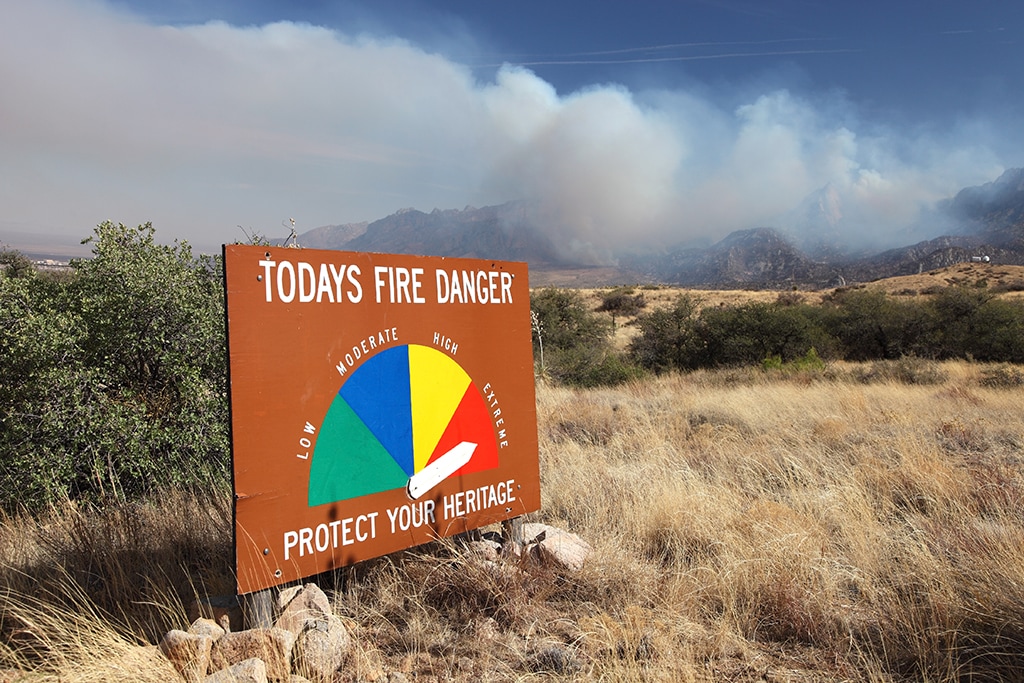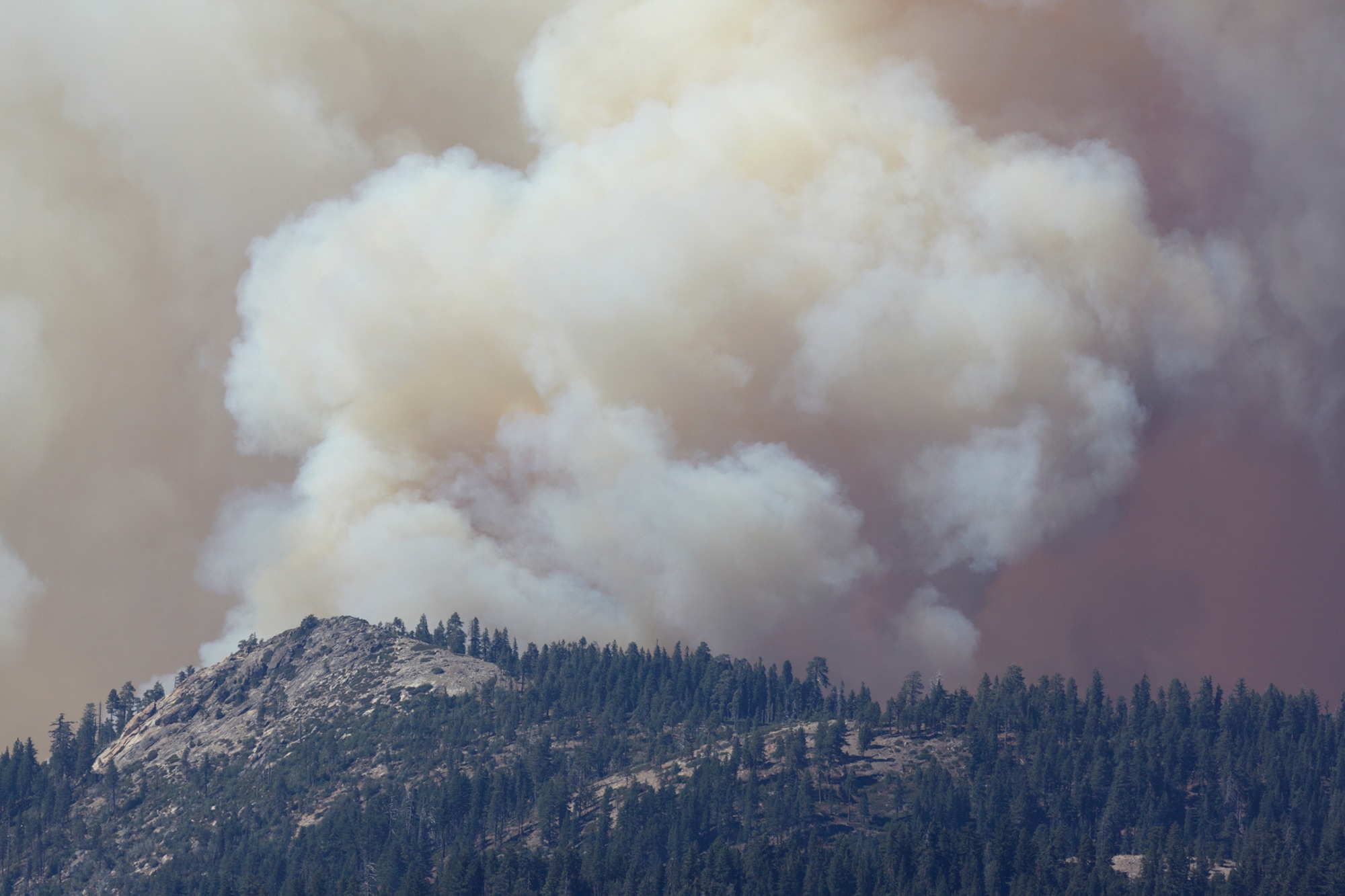When I returned to rainy Oregon after years of breathing in the soupy air of Delhi, India’s most polluted city, I assumed my days of blasting purifiers indoors and wearing filtration masks outdoors were long behind me. Yet last August, at a roadside viewpoint in Oregon’s Crater Lake National Park, I found myself peering into the caldera where plumes of smoke obscured the characteristic blue pool. I could have just as easily been standing in front of a gargantuan pit mine.
As a Pacific Northwesterner, I’ve traditionally approached seasons dichotomously. There’s summer, a few months characterized by blue sky and warm temperatures. Then there’s the chilly “rest of the year”—month after month of grey skies peppered with alternating drizzle and full-blown rain. Many of us in the PNW use this period of repose to plot out the perfect summer adventures of waking up before dawn to snag wilderness permits and campsite reservations the moment they are released. But over the past few years, we’ve seen a third period shoehorned between warm and rainy: fire season.
Things in Oregon got particularly bad in September 2020, when smoke billowed so thick that it transformed the late-summer sun into a dull, egg-yolk-hued blob. I recognized the scene from my Delhi days, when annual slash-and-burn practices in the surrounding plains brought with them months of nose-tingling smog. It wasn’t supposed to be like this in Oregon. Yet on September 11, 2020, the air quality index (AQI) in Portland, my hometown, was the highest in the world, followed by San Francisco and Seattle. Delhi ranked fifth.
Smoke and the Ecosystem
While wildfires have always been an integral part of the ecosystem, climate change appears to have brought longer wildfire seasons and larger fires. It’s a trend that is predicted to snowball in the years ahead, particularly if governments around the world—namely those in major-player developed countries like the United States—don’t take serious and immediate action. A recent United Nations Environment Programme report puts it best: “Not only can wildfires reduce biodiversity, but they contribute to a climate change feedback loop by emitting huge quantities of greenhouse gases into the atmosphere, spurring more warming, more drying, and more burning.”
One by-product of more intense fires is more intense smoke. Wildfire smoke is largely made up of particle pollution, also known as particulate matter (PM). In fact, about 90% of wildfire smoke comprises fine particles (i.e., those <2.5 microns in diameter or “PM2.5”), which are small enough for humans and animals to inhale. Inhaling these particles puts people at greater risk of respiratory and cardiovascular issues, and even death. In fact, exposure to smoke from landscape fires is estimated to be responsible for around 339,000 deaths per year worldwide.
Researchers have found that exposure to wildfire smoke not only causes a host of ailments in humans, but also wildlife. It can also impact their demographics. Wildfires kill wildlife and catalyze decline in their reproductive rates—notably in avian species. Studies have also shown that animal behavior can change after exposure to smoke—Bornean orangutans have been shown to rest more and move around less, and Bornean white-bearded gibbons vocalize less frequently and for shorter periods during smoky seasons. Even aquatic ecosystems are at risk—researchers studying Castle Lake in California in 2018 noted changes in temperature, ultraviolet radiation and production when smoke covered the lake for 55 days.
The agricultural industry is also impacted, and while wildfire smoke has been shown to help some plants use light more efficiently, it can also reduce productivity, even in farmland that’s far away from source fires. After all, wildfire smoke can travel thousands of miles, impacting the quality of air in areas far removed from active fires. During my visit, smoke from southern Oregon’s Bootleg Fire, which blanketed Crater Lake with smoke, had drifted all the way to the East Coast, creating its own weather systems in the process.
Fleeing from smoke
I certainly didn’t put much thought into smoke risk when I headed down to Crater Lake (originally named Giiwas by the Klamath people, who have lived in the area for thousands of years) for an overnight camping trip with my partner last summer. Although we were aware that fires were active in Southern Oregon, we were set to camp in a part of the forest that was situated far from any evacuation risk. We felt safe.
We began to question our decision about 90 minutes into our drive. As we approached Eugene, 100-odd miles south of Portland, the sky began to take on a sepia hue. Heading southwest over the Cascade Range and into the Umpqua National Forest (a land that has been home to several Native peoples: the Umpqua, Southern Molalla, Yoncalla and Cow Creek Band of Umpqua Tribe of Indians), the aroma of dusty campfire grew stronger with every milepost we passed. But, with a fire ban in place, there were no campfires. What we were smelling was smoke from faraway fires, casting a foreboding haze over the woods around us.
After attempting to take in the views at Crater Lake, we headed to our campground, a short drive from the park. The sun had already begun its descent by the time we arrived, and yet site after site at the usually packed campground remained empty. When we reached ours, we spent 20 minutes weighing the pros and cons of setting up camp for the night. Yes, it was smoky—but we lived in a particulate-filled city anyway. Would we really be that much worse off? Turning around would also mean another four or five hours of driving—surely, we could handle a smoky night in the woods. The longer we debated, the drier our throats grew, and our eyes began to sting. It was time to go home.
Planning ahead, mitigating risk
While having a strategy in place to get away from smoke is a must, it’s better to avoid wildfire smoke in the first place. “When it comes to recreating when there is a potential to encounter wildfire smoke, we encourage a ‘Know Before You Go’ approach,” says Forest Service spokesperson Wade Muehlhof. “People should check with the forest or ranger district where they plan to recreate to ensure they are aware of current conditions.”
But there’s still a chance that you might find yourself in a smoky situation during your summertime outdoor adventures, even with the best-laid plans. So how to handle it? For starters, don’t panic—the presence of smoke doesn’t necessarily mean you’re in imminent danger of encountering flames, and the smoke you’re smelling (and seeing) may be coming from many miles away. You’ll be able to tell a bit about the source fire by observing the smoke—for example, if the smoke column gets bigger, that’s a good indication that the fire is also getting bigger so it’s wise to get away quickly. Smoke columns also bend in the same direction that a fire is moving, so head in the opposite direction, if you can. (See Wildfire Safety Tips for Outdoor Recreation for more information about smoke safety.)
In one sense, we were lucky to have physical reactions to the smoke we encountered in Oregon—which made our decision to split easy. Other people aren’t as fortunate. Folks hoping to camp or hike where there’s enough smoke and pollution to be harmful, but not enough to notice face a tougher decision tree. “Your eyes, nose, and throat are all great early warning indicators that the wildfire smoke concentration is irritating,” says Tania Busch Isaksen, Ph.D., associate teaching professor at the University of Washington’s Department of Environmental and Occupational Health Sciences. She recommends downloading the EPA’s SmokeSense app and setting up push notifications, which can be a useful tool if you’re in an area with good service and data reporting. And it’s wise to keep N95s handy. “Always keep a new N95 mask with you to use if you find yourself in a smoky situation,” advises Busch Isaksen. An N95 “will reduce the amount of PM2.5 inhaled until you can get to an indoor location.”
It’s also crucial to remember that smoke impacts not only physical health, but also road safety. “Smoke can create visibility problems on roadways, including the formation of ‘superfog,’ a combination of smoke and dense fog that has resulted in numerous fatal vehicle accidents over the past few decades,” Muehlhof notes.
The Environmental Protection Agency’s (EPA) Airnow.gov is a simple web tool that allows users to look up both current and forecasted air quality information across the United States: AQI is regionally reported by the EPA and reflects the present quantities of pollution—including particle pollution as well as carbon monoxide and ground-level ozone, among others. Higher AQI values represent more potentially hazardous air conditions. Some National Parks also publish air quality health advisories, when necessary, on their Twitter feed. “If smoke is present and ground-level pollution monitors are detecting elevated fine particulate matter—PM2.5 is the size of particle we are most concerned about—then those at greater risk for poor health outcomes associated with wildfire smoke exposure may want to reconsider their trip,” advises Busch Isaksen.
Interestingly, it’s not just people with underlying conditions who should take extra care. “Our research is finding that those with underlying respiratory and cardiovascular health conditions are at increased risk of negative health outcomes with exposure to wildfire smoke, and that this risk increases significantly for those 45 and older,” Busch Isakesen says. Pets and livestock are also at high risk. The American Veterinary Medical Association advises monitoring animals for a host of symptoms, including breathing difficulties, disorientation, watering eyes and weakness—but it’s best to avoid smoky situations altogether when traveling with pets.
“As an avid camper/hiker myself, I know there is nothing more frustrating than having our plans—many of which were crafted and reserved the previous January—thwarted by wildfire smoke,” Busch Isaksen says. “Knowing your own party’s health limits and checking in for AQI/wildfire smoke plume information before you head out is important to ensuring everyone’s around for another January planning session.”

What to do when you get smoked out
If wildfire smoke forces you to cancel your camping plans, fear not: You may be able to get at least a partial refund, sometimes minus a cancellation fee and/or the cost of the first night. If a campground is shut down due to wildfire- or smoke-related risks, you should receive an automated cancellation email and information about a refund or rebooking.
This summer, my partner and I have decided to plan our biggest summer adventures for earlier in the season, before the risk of fire is at its highest. We’ve yet to visit Lake Tahoe due to two consecutive years of wildfire-related campground cancellations, and last summer’s camping debacle has us rethinking our approach to planning ahead altogether. We still have permits for a backpacking trip this summer, passing through sections of Oregon’s Jefferson Wilderness that were engulfed in flames less two years ago, but—by and large—we plan to play our outdoor adventures by ear this summer. If we’re lucky, we may even get to see Crater Lake.


